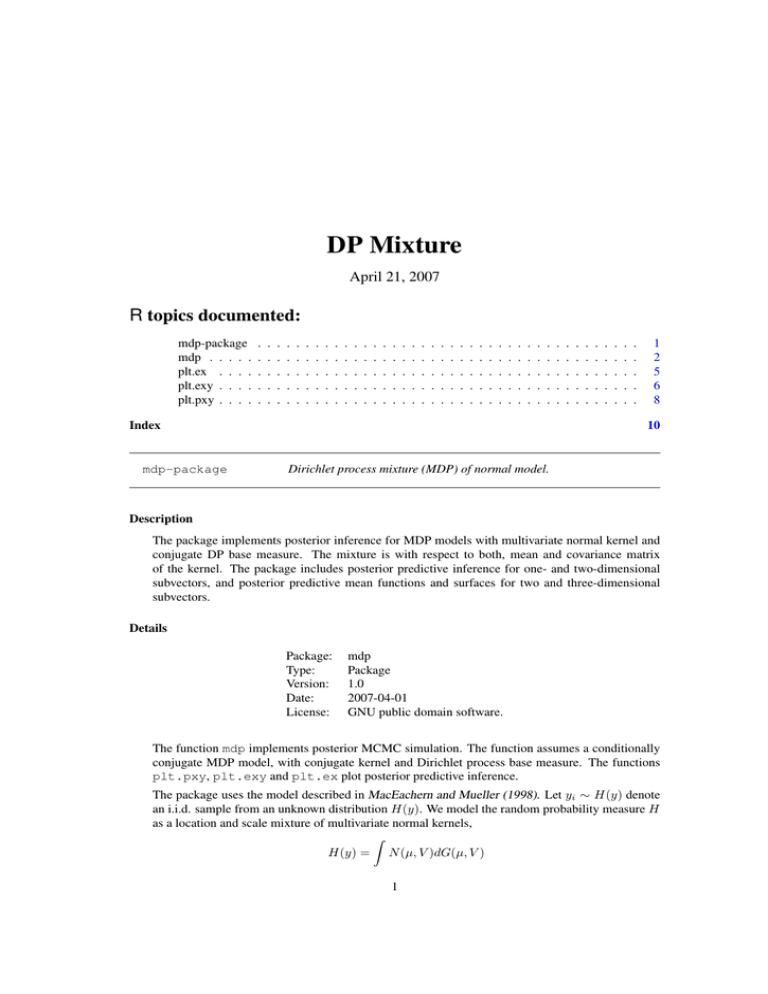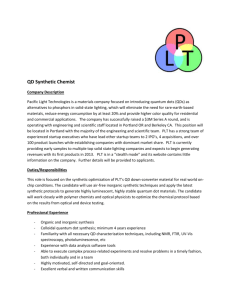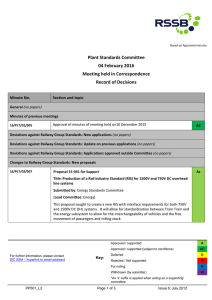DP Mixture R topics documented: April 21, 2007
advertisement

DP Mixture April 21, 2007 R topics documented: mdp-package mdp . . . . . plt.ex . . . . plt.exy . . . . plt.pxy . . . . . . . . . . . . . . . . . . . . . . . . . . . . . . . . . . . . . . . . . . . . . . . . . . . . . . . . . . . . . . . . . . . . . . . . . . . . . . . . . . . . . . . . . . . . . . . . . . . . . . . . . . . . . . . . . . . . . . . . . . . . . . . . . . . . . . . . . . . . . . . . . . . . . . . . . . . . . . . Index mdp-package . . . . . . . . . . . . . . . . . . . . . . . . . . . . . . . . . . . . . . . . . . . . . 1 2 5 6 8 10 Dirichlet process mixture (MDP) of normal model. Description The package implements posterior inference for MDP models with multivariate normal kernel and conjugate DP base measure. The mixture is with respect to both, mean and covariance matrix of the kernel. The package includes posterior predictive inference for one- and two-dimensional subvectors, and posterior predictive mean functions and surfaces for two and three-dimensional subvectors. Details Package: Type: Version: Date: License: mdp Package 1.0 2007-04-01 GNU public domain software. The function mdp implements posterior MCMC simulation. The function assumes a conditionally conjugate MDP model, with conjugate kernel and Dirichlet process base measure. The functions plt.pxy, plt.exy and plt.ex plot posterior predictive inference. The package uses the model described in MacEachern and Mueller (1998). Let yi ∼ H(y) denote an i.i.d. sample from an unknown distribution H(y). We model the random probability measure H as a location and scale mixture of multivariate normal kernels, Z H(y) = N (µ, V )dG(µ, V ) 1 2 mdp with a Dirichlet process (DP) prior for the mixing measure, G ∼ DP (G0 , α) and a conditionally conjugate base measure G0 (µ, V −1 ) = Gµ0 (µ)GV 0 (V −1 ) where Gµ0 (µ) = N (m, B) and GV 0 (V −1 ) = W ishart(s, (sS)−1 ). The Wishart distribution is parametrized such that E(V−1 ) = S −1 . We assume conjugate hyperpriors m ∼ N (a, A), B −1 ∼ W ishart(c, (cC)−1 ), S ∼ W ishart(q, R/q). The model is completed with a Gamma prior for the total mass paramter α ∼ Ga(a0 , b0 ). Author(s) Peter Mueller Maintainer: Peter Mueller <pm@wotan.mdacc.tmc.edu> References The package uses the parametrization defined in: MacEachern, S.N. and Mueller, P. (1998). “Estimating Mixture of Dirichlet Process Models,” Journal of Computational and Graphical Statistics, 7, 223–239. See Also See also the package DPpackage, at http://student.kuleuven.be/~s0166452/software.html. mdp MDP – Dirichlet process mixture of normals Description Fits a semiparametric Dirichlet process mixture of normals. Usage mdp(n = NULL, p = NULL, n.iter = 10000, n.discard = 1000, n.reinit = 10000, n.batch = 100, n.predupdate = 100, n.printallpars = 1000, m.prior = F, B.prior = F, verbose = 3, pxy = F, exy = F, ex = F, s = 15, S.init = NULL, q = 5, R = NULL, B.init = NULL, cc = 5, C = NULL, m.init = NULL, a = NULL, A = NULL, alpha = 1, a0 = 1, b0 = 1, k0 = NULL, Y = NULL) mdp 3 Arguments n number of data records p dimension of each data record n.iter number MCMC iterations n.discard initial transient n.reinit reinitialize every n.reinit iterations (not normally used) n.batch save imputed parameters every n.batch iterations n.predupdate save posterior predictive summaries every n.predupdate iterations n.printallpars print all parameters every n.printallpars iterations m.prior indicator for resampling (1) versus fixing (0) the mean of the base measure, m B.prior indicator for resampling (1) versus fixing (0) the variance-covariance matrix of the base measure, B verbose level of comments pxy indicator for evaluating posterior predictive p(x, y | data) for a future observation. Indices of x, y are given in ix and iy exy indicator for evaluating posterior predictive expectation E(z | x, y, data) for a future observation. Indices of x, y, z are given in ix,iy and iz ex indicator for evaluating posterior predictive p(x, y | data) for a future observation. Indices of x, y are given in ix and iy S.init initial value for the kernel covariance matrix S s degrees of freedom for the inverse Wishart prior on S q degrees of freedom for the inverse Wishart base measure for G0 (Vi ) R expectation of the inverse Wishart base measure G0 (Vi ) R Describe R here B.init initial value for the covariance matrix B of the base measure G0 (µ) = N (m, B) cc degrees of freedom of the inverse Wishart hyperprior for B C mean of the inverse Wishart hyperprior for B m.init initial value for the mean m of the base measure G0 (µ) = N (m, B) a hyperprior mean for m A hyperprior covariance matrix for m alpha initial value for the total mass parameter alpha a0 hyperprior parameters for prior on total mass paramter α b0 hyperprior parameters for prior on total mass paramter α k0 initial number of distinct clusters Y n by p data matrix Details See mdp-package for a statement of the probability model. The function mdp initializes and carries out MCMC posterior simulation. Simulation output is saved in the working directory. Change it by using setwd if desired. 4 mdp Value The function returns no value. Simulation output is written to files. Note Careful, mdp writes temporary files into the current working directory. The same files are used by plt.pxy, plt.ex and plt.exy to plot posterior predictive distributions and expectations. References the package uses the parametrization defined in: MacEachern, S.N. and Mueller, P. (1998). “Estimating Mixture of Dirichlet Process Models,” Journal of Computational and Graphical Statistics, 7, 223–239. See Also See also the DPpackage, at http://student.kuleuven.be/~s0166452/software.html. Examples ## Not run: ## Data from Lubischew, A. (1962), "On the use of discriminant functions ## in taxonomy," Biometrics, 18, 455-477. data.dir <- system.file("demo",package="mdp") beetles <- file.path(data.dir,"beetle.data") Y <- read.table(beetles) # beetle data. The last column reports species p <- ncol(Y) Y <- as.matrix(Y[,-p]) # don't use the species indicator ## run MCMC ## mdp(Y=Y, pxy=1,exy=1,ex=1,ix=1,iy=2,iz=3, q=10,cc=10) ## plot results ## plt.pxy(img=T,lg=T) points(Y[,1],Y[,2],pch=19) plt.pxy(img=F,lg=F) points(Y[,1],Y[,2],pch=19) ## biv density estimate p(x,y), ## x=1st col (ix), y=2nd column (iy) # add data points # same as a contour plot plt.ex(sd=T,zlab="f(x)=E(z | x)") plt.ex(sim=T,zlab="f~p(f | data)") plt.exy() ## E(z | x, data), for z=3rd col (iz) ## show random draws from p(f | data) ## E(z | x,y, data) ## note: for marginals on different coordinates need to ## re-run mdp with new values for ix,iy,iz ## End(Not run) plt.ex plt.ex 5 Conditional mean curve f(x) Description Plots the estimated conditional mean curve E[fH (x) | data], for the fH (x) = EH (z | x). The first expectation is under the posterior distribution on H given the data. The second expectation is with respect to H. Here H(.) is the random probability distribution modeled by the DP mixture of normals. See mdp-package for a statement. Usage plt.ex <- function(xlab="X",zlab="Z", xlim=NULL,ylim=NULL, bty="l", sd=FALSE, sim=FALSE) Arguments xlab label on the x-axis ylab label on the vertical axis (plotting z). xlim domain of the x-axis ylim domain of the vertical axis sd sim indicator for adding 10 random draws for fH . Details Need to call mdp first to carry out the posterior Markov chain Monte Carlo simulation. The function plt.ex uses the simulation output to produce the desired posterior estimated conditional mean function. The function assumes the simulation output is saved in the current working directory. Change it by using setwd if necessary. The random draws (under sim=TRUE) are generated from p(fH | data). See mdp-package for a statement of the probability model for the random probability measure H. Value The function returns no value. Note Careful, mdp writes temporary files into the current working directory. References the package uses the parametrization defined in: MacEachern, S.N. and Mueller, P. (1998). “Estimating Mixture of Dirichlet Process Models,” Journal of Computational and Graphical Statistics, 7, 223–239. 6 plt.exy See Also See also the R library DPpackage, at http://student.kuleuven.be/~s0166452/software.html. Examples ## Not run: ## Data from Lubischew, A. (1962), "On the use of discriminant functions ## in taxonomy," Biometrics, 18, 455-477. data.dir <- system.file("demo",package="mdp") beetles <- file.path(data.dir,"beetle.data") Y <- read.table(beetles) # beetle data. The last column reports species p <- ncol(Y) Y <- as.matrix(Y[,-p]) # don't use the species indicator ## run MCMC ## mdp(Y=Y, pxy=1,exy=1,ex=1,ix=1,iy=2,iz=3, q=10,cc=10) ## plot results ## plt.pxy(img=T,lg=T) points(Y[,1],Y[,2],pch=19) ## biv density estimate p(x,y), ## x=1st col (ix), y=2nd column (iy) # add data points plt.pxy(img=F,lg=F) points(Y[,1],Y[,2],pch=19) # same as a contour plot plt.ex(sd=T) plt.ex(sim=T) ## E(z | x, data), for z=3rd col (iz) ## show random draws from p(f | data) plt.exy() ## E(z | x,y, data) ## note: for marginals on different coordinates need to ## re-run mdp with new values for ix,iy,iz ## End(Not run) plt.exy Conditional mean surface f(x,y). Description Plots the estimated conditional mean curve E[f (x, y) | data], for the fH (x, y) = EH (z | x, y). The first expectation is under the posterior distribution on H given the data. The second expectation is with respect to H. Here H(.) is the random probability distribution modeled by the DP mixture of normals. See mdp-package for a statement. Usage plt.exy <- function(xlab="X",ylab="Y",zlab="Z", plt.contour=TRUE) plt.exy 7 Arguments xlab label on the x-axis ylab label on the y-axis zlab label on the z-axis plt.contour indicator for using a contour plot vs. an image plot Details Need to call mdp first to carry out the posterior Markov chain Monte Carlo simulation. The function plt.exy uses the simulation output to produce the desired posterior estimated conditional mean function. The function assumes the simulation output is saved in the current working directory. Change it by using setwd if necessary. See mdp-package for a statement of the probability model for the random probability measure H. Value The function returns no value. Note Careful, mdp writes temporary files into the current working directory. References the package uses the parametrization defined in: MacEachern, S.N. and Mueller, P. (1998). “Estimating Mixture of Dirichlet Process Models,” Journal of Computational and Graphical Statistics, 7, 223–239. See Also See also the R library DPpackage, at http://student.kuleuven.be/~s0166452/software.html. Examples ## Not run: ## Data from Lubischew, A. (1962), "On the use of discriminant functions ## in taxonomy," Biometrics, 18, 455-477. data.dir <- system.file("demo",package="mdp") beetles <- file.path(data.dir,"beetle.data") Y <- read.table(beetles) # beetle data. The last column reports species p <- ncol(Y) Y <- as.matrix(Y[,-p]) # don't use the species indicator ## run MCMC ## mdp(Y=Y, pxy=1,exy=1,ex=1,ix=1,iy=2,iz=3, q=10,cc=10) 8 plt.pxy ## plot results ## plt.pxy(img=T,lg=T) points(Y[,1],Y[,2],pch=19) ## biv density estimate p(x,y), ## x=1st col (ix), y=2nd column (iy) # add data points plt.pxy(img=F,lg=F) points(Y[,1],Y[,2],pch=19) # same as a contour plot plt.ex(sd=T) plt.ex(sim=T) ## E(z | x, data), for z=3rd col (iz) ## show random draws from p(f | data) plt.exy() ## E(z | x,y, data) ## note: for marginals on different coordinates need to ## re-run mdp with new values for ix,iy,iz ## End(Not run) plt.pxy Bivariate posterior predictive Description Plots the bivariate density estimate p(x, y) = E[H(x, y) | data]. Usage plt.pxy <- function(xlab="X",ylab="Y", xlim=NULL,ylim=NULL, lg=F, img=T) Arguments xlab label on the x-axis ylab label on the y-axis xlim domain of the x-axis ylim domain of the y-axis lg img indicator for image plot vs. contours Details Need to call mdp first to carry out the posterior Markov chain Monte Carlo simulation. The function plt.pxy uses the simulation output to produce the desired posterior predictive distribution. The function assumes the simulation output is saved in the current working directory. Change it by using setwd if necessary. See mdp-package for a statement of the probability model for the random probability measure H. Here H(.) is the random probability distribution modeled by the DP mixture of normals. See mdp-package for a statement. plt.pxy 9 Value The function returns no value. Note Careful, mdp writes temporary files into the current working directory. The same files are used by plt.pxy, plt.ex and plt.exy to plot posterior predictive distributions and expectations. References the package uses the parametrization defined in: MacEachern, S.N. and Mueller, P. (1998). “Estimating Mixture of Dirichlet Process Models,” Journal of Computational and Graphical Statistics, 7, 223–239. See Also See also the R library DPpackage, at http://student.kuleuven.be/~s0166452/software.html. Examples ## Not run: ## Data from Lubischew, A. (1962), "On the use of discriminant functions ## in taxonomy," Biometrics, 18, 455-477. data.dir <- system.file("demo",package="mdp") beetles <- file.path(data.dir,"beetle.data") Y <- read.table(beetles) # beetle data. The last column reports species p <- ncol(Y) Y <- as.matrix(Y[,-p]) # don't use the species indicator ## run MCMC ## mdp(Y=Y, pxy=1,exy=1,ex=1,ix=1,iy=2,iz=3, q=10,cc=10) ## plot results ## plt.pxy(img=T,lg=T) points(Y[,1],Y[,2],pch=19) ## biv density estimate p(x,y), ## x=1st col (ix), y=2nd column (iy) # add data points plt.pxy(img=F,lg=F) points(Y[,1],Y[,2],pch=19) # same as a contour plot plt.ex(sd=T) plt.ex(sim=T) ## E(z | x, data), for z=3rd col (iz) ## show random draws from p(f | data) plt.exy() ## E(z | x,y, data) ## note: for marginals on different coordinates need to ## re-run mdp with new values for ix,iy,iz ## End(Not run) Index ∗Topic package mdp-package, 1 DPpackage, 2, 4, 5, 7, 9 mdp, 2, 5, 7, 8 mdp-package, 3–8 mdp-package, 1 plt.ex, 4 plt.exy, 6 plt.pxy, 8 10






